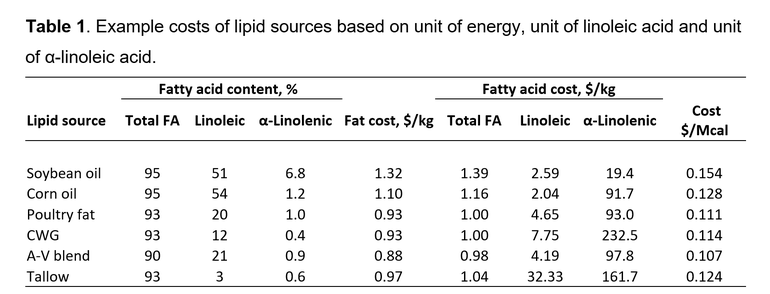Applying essential fatty acid research to improve reproduction in sows
Minimum linoleic acid intake level should be targeted for 90-95% of sows.
March 4, 2021

We reported previously in National Hog Farmer on a major milestone that was achieved with the discovery that two essential fatty acids (EFA) are deficient in lactation diets of sows experiencing moderate heat stress. These EFA, linoleic and α-linolenic acid, are directly involved in a variety of reproduction processes, and a deficiency results in poor return to estrus, low farrowing rate, and decreased litter size. Resolving seasonal anestrous depends on adequate intake of each EFA during lactation.
Results of our past (references below) and our current work demonstrates that EFA supplementation during lactation directly affects subsequent reproduction and increases the number of pigs born per 100 sows weaned (pigs born index). We further demonstrated that this phenomenon was increasingly important to advancing sow age. Based on dose-response curves, we estimate that the near maximum response to total dietary linoleic acid intake is achieved when sows consume a minimum of 125 g linoleic acid daily during lactation. This estimate is based on the pigs born index to represent a financially optimum intake of linoleic acid during lactation.
We propose that the minimum linoleic acid intake level should be targeted for 90-95% of the sows (rather than the average), which is especially important in an all or none scenario, where sows either maintain their pregnancy or not. Thus, sows that are compromised by having lower intake than the average of the population will consume adequate levels of linoleic acid to allow for a successful pregnancy.
This ultimately requires knowledge of seasonal lactation intake and the variation associated with feed intake, such that the minimum linoleic acid intake (g/d) can be achieved by most sows. For example, if the average daily feed intake of sows during the summer is predicted to be 5.5 kg per day and the bottom 10% of the sows are expected to consume 4.0 kg per day, then the dietary concentration of linoleic acid can be calculated to be 3.1% to achieve 125 g per day of linoleic acid intake for at least 90% of the sows in the population.
This also implies that diets should be formulated according to seasonal variation in intake, with dietary specifications for linoleic acid being greater in the summer than in the winter. Formulating diets by adding lipids according the EFA specifications rather than using lipids to formulate high-energy diets may present cost savings because of lower lipid inclusion rates. However, the cost of lipid sources relative to their content of EFA should be considered (Table 1). For example, when formulating diets based on their cost per unit of metabolizable energy (ME), animal-vegetable (A-V) blend, poultry fat, and choice white grease (CWG) are most cost effective because they are the lowest cost per unit of energy (0.107, 0.111, and 0114 $/Mcal of ME, respectively). On the other hand, when formulating on a linoleic acid basis, corn oil and soybean oil are most cost competitive ($2.04 and $2.59/unit of linoleic acid, respectively).
It should be noted that soybean oil also contains a substantial amount of α-linolenic acid compared to other commercially available lipid sources. Our research, not shown herein, suggested that a minimum dietary intake of α-linolenic of 10 g/day during lactation was beneficial for subsequent reproductive performance.

We conclude that a minimum dietary intake of 125 g/d of linoleic acid together with a minimum of 10 g/d of α-linolenic acid should be provided to at least 90-95% of the sows. This should be done to achieve maximum sow reproductive efficiency through multiple mechanisms, including rapid return to estrus, high maintenance of pregnancy, and large subsequent litter size in mature sows, which appear to be especially susceptible to EFA deficiency.
The findings described here represent a tremendous step forward towards resolving seasonal anestrous that has plagued the swine industry for decades. Practical application of EFA supplementation has proven successful against seasonal infertility in commercial production systems.
Sources: Eric van Heugten, David Rosero, and R. Dean Boyd, North Carolina State University, The Hanor Company, are solely responsible for the information provided, and wholly own the information. Informa Business Media and all its subsidiaries are not responsible for any of the content contained in this information asset.
References:
Rosero, D. S. R. D. Boyd, J. Odle, and E. van Heugten. 2016. Optimizing dietary lipid use to improve essential fatty acid status and reproductive performance of the modern lactating sow: a review. J. Anim. Sci. Biotechn. 7(34):1-18.
Rosero, D. S., R. D. Boyd, M. McCulley, J. Odle, and E. van Heugten. 2016. Essential fatty acid supplementation during lactation is required to maximize the subsequent reproductive performance of the modern sow. Anim. Repro. Sci. 168:151-163.
Rosero D. S., S. Mendoza, J. Odle, R. D. Boyd, V. Fellner, and E. van Heugten. 2015. Impact of dietary lipids on milk composition and balance of essential fatty acids during lactation. J. Anim. Sci. 93:2935-2947.
Rosero, D. S., E. van Heugten, J. Odle, C. Arellano, and R. D. Boyd. 2012. Response of the modern lactating sow and progeny to source and level of supplemental dietary fat during high ambient temperatures. J. Anim. Sci. 90:2609-2619.
Rosero, D. S., E. van Heugten, J. Odle, R. Cabrera, C. Arellano, and R. D. Boyd. 2012. Sow and litter response to supplemental dietary fat in lactation diets during high ambient temperatures. J. Anim. Sci. 90:550-559.
You May Also Like



